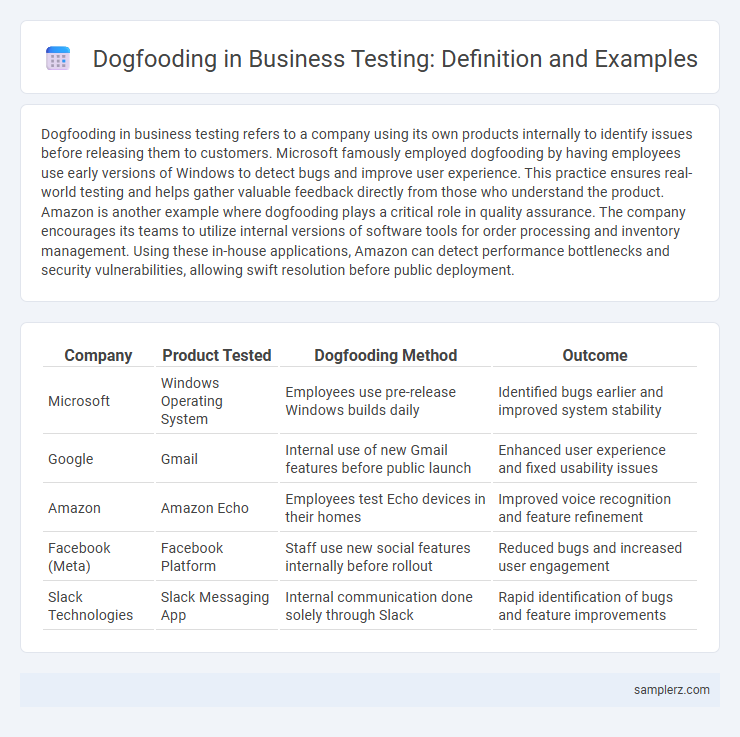Dogfooding in business testing refers to a company using its own products internally to identify issues before releasing them to customers. Microsoft famously employed dogfooding by having employees use early versions of Windows to detect bugs and improve user experience. This practice ensures real-world testing and helps gather valuable feedback directly from those who understand the product. Amazon is another example where dogfooding plays a critical role in quality assurance. The company encourages its teams to utilize internal versions of software tools for order processing and inventory management. Using these in-house applications, Amazon can detect performance bottlenecks and security vulnerabilities, allowing swift resolution before public deployment.
Table of Comparison
| Company | Product Tested | Dogfooding Method | Outcome |
|---|---|---|---|
| Microsoft | Windows Operating System | Employees use pre-release Windows builds daily | Identified bugs earlier and improved system stability |
| Gmail | Internal use of new Gmail features before public launch | Enhanced user experience and fixed usability issues | |
| Amazon | Amazon Echo | Employees test Echo devices in their homes | Improved voice recognition and feature refinement |
| Facebook (Meta) | Facebook Platform | Staff use new social features internally before rollout | Reduced bugs and increased user engagement |
| Slack Technologies | Slack Messaging App | Internal communication done solely through Slack | Rapid identification of bugs and feature improvements |
Introduction to Dogfooding in Business Testing
Dogfooding in business testing involves companies using their own products internally before releasing them to customers, ensuring firsthand experience with functionality and usability. This practice accelerates the identification of bugs and enhances product quality by leveraging real-world scenarios within the organization. Microsoft and Google are prominent examples, successfully implementing dogfooding to refine software products before public launch.
Understanding the Concept of Dogfooding
Dogfooding in business testing involves a company using its own product internally to identify issues and improve quality before market release. This practice enables direct user feedback from employees deeply familiar with the product's goals and functionalities, enhancing problem detection and usability. Companies like Microsoft and Google have successfully leveraged dogfooding to refine software by exposing real-world challenges during development.
Why Companies Use Dogfooding for Product Testing
Companies use dogfooding for product testing to identify usability issues early by having employees experience the product firsthand, ensuring higher quality and reliability. This internal usage fosters a deeper understanding of the product, leading to quicker feedback loops and more targeted improvements. By simulating real-world scenarios, companies reduce the risk of defects reaching customers and improve overall user satisfaction.
Key Benefits of Dogfooding in Business Environments
Dogfooding in business environments accelerates product improvement by enabling teams to identify and resolve real-world issues early, enhancing software quality and user satisfaction. This internal testing approach fosters stronger team collaboration and a culture of accountability, driving innovation and aligning product development closely with customer needs. Companies like Microsoft and Google leverage dogfooding to reduce time-to-market and minimize costly post-launch defects.
Real-life Examples of Dogfooding in Tech Companies
Tech giants like Google implement dogfooding by having employees use early versions of products such as Gmail and Google Workspace to identify bugs and enhance features before public release. Microsoft applies dogfooding extensively in Windows and Office product development, enabling internal teams to catch usability issues and performance glitches. Facebook's practice of dogfooding involves employees actively engaging with new tools like Workplace to gather authentic feedback and fine-tune user experience.
Case Study: Successful Dogfooding Implementation
In a notable case study, Microsoft implemented dogfooding by having its employees exclusively use the Windows 10 operating system internally before its public release, enabling real-time identification and resolution of user experience issues. This approach accelerated feedback cycles and improved software stability by integrating employee insights directly into the development process. As a result, Microsoft achieved a more polished final product and reduced post-launch support costs significantly.
Common Challenges During Dogfooding
Dogfooding often encounters challenges such as limited user diversity, leading to overlooked bugs and insufficient real-world scenario coverage. Internal bias may cause testers to assume certain features work intuitively, reducing critical feedback effectiveness. Resource constraints and conflicting priorities between development and testing teams can delay issue identification and resolution during the dogfooding process.
Best Practices for Dogfooding in Product Testing
Implementing dogfooding in product testing involves using the product internally to identify usability issues and gather authentic feedback from employees who simulate real customer experiences. Best practices include establishing clear testing goals, selecting diverse internal users across departments, and continuously documenting feedback to prioritize improvements. Regularly updating the product based on internal insights accelerates quality enhancements and aligns releases with actual user needs.
Measuring the Impact of Dogfooding on Product Quality
Implementing dogfooding in product testing allows businesses to gather authentic user feedback by having employees use their own products in real scenarios. Metrics such as defect rates, user satisfaction scores, and time-to-resolution for issues reported during dogfooding provide quantitative insights into product quality improvements. Continuous monitoring of these indicators reveals direct correlations between dogfooding practices and enhanced product reliability, usability, and overall customer experience.
Future Trends: Dogfooding and Agile Development
Dogfooding in testing enhances Agile development by fostering rapid feedback loops and continuous improvement, crucial for future business innovation. Companies integrating dogfooding practices with Agile frameworks achieve higher product quality and user satisfaction through iterative, real-world testing. This approach accelerates deployment cycles and adapts swiftly to market demands, positioning businesses ahead in competitive landscapes.

example of dogfooding in testing Infographic
 samplerz.com
samplerz.com